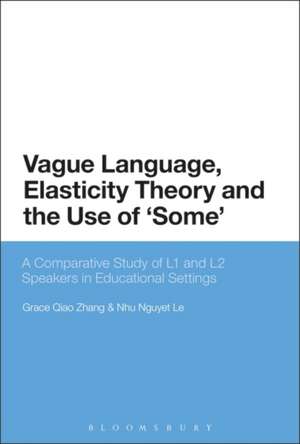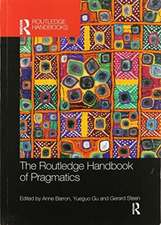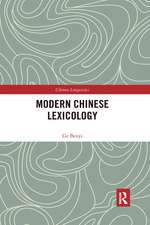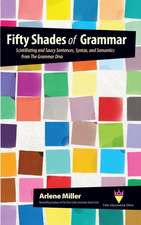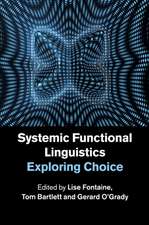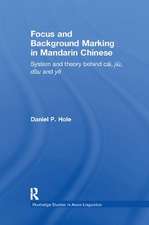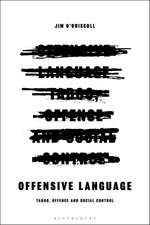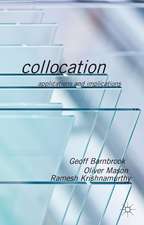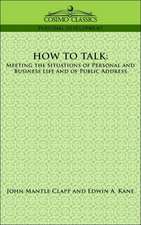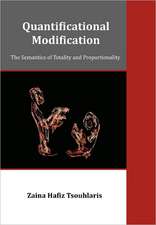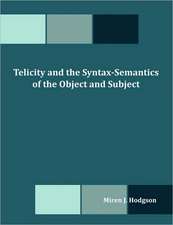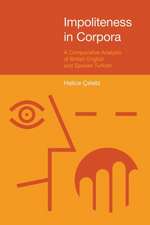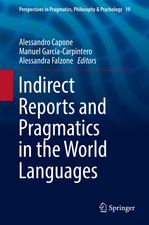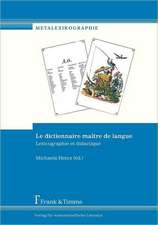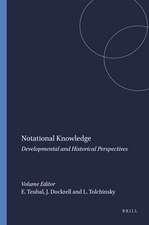Vague Language, Elasticity Theory and the Use of ‘Some’: A Comparative Study of L1 and L2 Speakers in Educational Settings
Autor Grace Qiao Zhang, Nhu Nguyet Leen Limba Engleză Paperback – 25 dec 2019
| Toate formatele și edițiile | Preț | Express |
|---|---|---|
| Paperback (1) | 229.96 lei 6-8 săpt. | |
| Bloomsbury Publishing – 25 dec 2019 | 229.96 lei 6-8 săpt. | |
| Hardback (1) | 772.98 lei 6-8 săpt. | |
| Bloomsbury Publishing – 27 iun 2018 | 772.98 lei 6-8 săpt. |
Preț: 229.96 lei
Preț vechi: 264.62 lei
-13% Nou
Puncte Express: 345
Preț estimativ în valută:
44.01€ • 47.79$ • 36.97£
44.01€ • 47.79$ • 36.97£
Carte tipărită la comandă
Livrare economică 22 aprilie-06 mai
Preluare comenzi: 021 569.72.76
Specificații
ISBN-13: 9781350143876
ISBN-10: 1350143871
Pagini: 216
Ilustrații: 47 bw illus
Dimensiuni: 156 x 234 x 12 mm
Greutate: 0.3 kg
Editura: Bloomsbury Publishing
Colecția Bloomsbury Academic
Locul publicării:London, United Kingdom
ISBN-10: 1350143871
Pagini: 216
Ilustrații: 47 bw illus
Dimensiuni: 156 x 234 x 12 mm
Greutate: 0.3 kg
Editura: Bloomsbury Publishing
Colecția Bloomsbury Academic
Locul publicării:London, United Kingdom
Caracteristici
The
book
features
three
distinct
sets
of
naturally-occurring
classroom
data:
L1
speakers
of
American
English,
Chinese-speaking
learners
of
English,
and
Vietnamese-speaking
learners
of
English
Notă biografică
Grace
Qiao
Zhangis
an
Associate
Professor
at
Curtin
University,
Australia.
She
was
awarded
a
Ph.D.
in
Linguistics
by
the
University
of
Edinburgh,
UK.
She
has
published
extensively
on
linguistics
and
Chinese
linguistics.Nhu
Nguyet
Lehas
a
PhD
in
Linguistics
from
Curtin
University,
Australia
and
is
a
researcher
in
vague
language.
Cuprins
1.
Introduction2.
Theoretical
Foundations3.
Methodology4.
'Some'
and
'Some'
Clusters5.
Pragmatic
Functions
of
'Some'6.
General
Discussion7.
Conclusions
and
ImplicationsBibliographyIndex
Recenzii
A
welcome
book
which
provides
a
wealth
of
data
and
potentially
interesting
ideas
onsomewhich
can
be
used
to
help
linguists
and
language
teachers
understand
the
differences
between
different
L1
and
L2
groups.
It
prompts
questions
about
whethersomeis
a
device
that
L2
speakers
use
to
avoid
more
complex
and
linguistically
demanding
explanations
or
whether
they
use
some
to
cover
gaps
in
their
lexical
stores.
The book reveals the elasticity of 'some' in language communication and the importance of Elasticity Theory in the studies of vague languages by the corpus-based linguistic and pragmatic approaches to the elasticity of 'some' in English uses in three different cultural/educational settings. It fills the gap in the existing literature by bringing new insights to the study of some and beyond.
Solidly grounded in a mixed-methods approach in its research design, Nhu Nguyet Le and Grace Qiao Zhang's book provides a wealth of insight into how the vague item 'some' is used by both American English speakers as well as Chinese and Vietnamese learners of English. Drawing on insight from Grace Zhang's intellectually stimulating theory of 'vague language elasticity', the book throws light on how 'some' can be used in pragmatically elastic ways by culturally diverse interactants. If you are researching vague language use, Le and Zhang's book has a lot to offer.
By a mixed method of quantitative and qualitative approaches to the mixed resources of the vague wordsome, Nhu Nguyet Le and Grace Qiao Zhang are making their further contribution to the elasticity of natural languages. If you are in any way concerned with demystifying how human beings configure the world and communicate it economically, you owe it to yourself to read this book.
This impressive and engaging book by Nhu Nguyet Le and Grace Qiao Zhang is the first to provide a systematic and comprehensive analysis ofsomethrough the fresh elasticity theory. The authors look at the versatile pragmatic functions as well as lexical and syntactic roles this vague item performs in spoken educational contexts. Adopting a mixed-methods approach for the readers' profound understanding of the functions ofsomein L1 versus L2, this insightful book can serve an invaluable resource for all involved in pragmatics and intercultural communication.
The book reveals the elasticity of 'some' in language communication and the importance of Elasticity Theory in the studies of vague languages by the corpus-based linguistic and pragmatic approaches to the elasticity of 'some' in English uses in three different cultural/educational settings. It fills the gap in the existing literature by bringing new insights to the study of some and beyond.
Solidly grounded in a mixed-methods approach in its research design, Nhu Nguyet Le and Grace Qiao Zhang's book provides a wealth of insight into how the vague item 'some' is used by both American English speakers as well as Chinese and Vietnamese learners of English. Drawing on insight from Grace Zhang's intellectually stimulating theory of 'vague language elasticity', the book throws light on how 'some' can be used in pragmatically elastic ways by culturally diverse interactants. If you are researching vague language use, Le and Zhang's book has a lot to offer.
By a mixed method of quantitative and qualitative approaches to the mixed resources of the vague wordsome, Nhu Nguyet Le and Grace Qiao Zhang are making their further contribution to the elasticity of natural languages. If you are in any way concerned with demystifying how human beings configure the world and communicate it economically, you owe it to yourself to read this book.
This impressive and engaging book by Nhu Nguyet Le and Grace Qiao Zhang is the first to provide a systematic and comprehensive analysis ofsomethrough the fresh elasticity theory. The authors look at the versatile pragmatic functions as well as lexical and syntactic roles this vague item performs in spoken educational contexts. Adopting a mixed-methods approach for the readers' profound understanding of the functions ofsomein L1 versus L2, this insightful book can serve an invaluable resource for all involved in pragmatics and intercultural communication.
